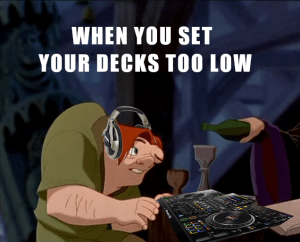Want to get better at scratching? Whether you are a beginner or a pro, here you have an easy-to-follow, step-by-step guide to consistently improve your scratch DJ game.
All you need is your scratching gear of choice and some love for the music!

First of all, let’s talk about a very important matter which has very little coverage: scratching IS playing and the decks are your instrument! Do not be fooled by the fact that some may view scratching or djing in general as a lower-grade musical activity.
Turntables and mixers are a proper musical instrument and they must be learned through constant practice, just as you would do for piano, guitar or trombone.
This means that your focus has to be on practicing a little every day. If you are a beginner, I promise you that if you scratch at least 10 minutes a day, you will constantly improve, get better and develop serious skills.
6 Ways to Get Better at Scratching as a DJ
1) STRETCH AND WARM UP
It may seem far-fetched but this is important. Obviously, scratching is not a physical demanding activity from which you can be injured (at least practicing in your bedroom). But, particularly if you are a beginner, you do not want to start with say, for example, crabs at 180 BPM right away. This would get your hands sore and destroy your will to practice, I guarantee it.

In scratching, your hands make two basic movements: the fader cut and the disc/platter spin. They are not hard movements per se, but they are very repetitive, and they can be demanding, especially for your wrists. So once you’ve turned everything on and set your gear at the right height (don’t hunchback dj!), do some warm up:
- rotate your wrists
- open and close your hands
- touch the tip of your fingers with the thumb
- stretch your forearms
- relax your shoulders and back
It doesn’t need to be a tedious or long exercise, a couple of minutes is plenty of time to get your blood peripherical circulation going, your tendons loose and your muscles warm.
2) GET IN THE FLOW
After you made yourself comfortable, it is now time to get into business. You have to bring your mind in the state of the music. It can be whatever you want, jam on some tunes, do some basics beat juggles, even just listen to something you like or made.
What I prefer to do is putting up some instrumentals I dig and start scratching. I find that this is the easiest and quickest method to get myself in the flow, and zone out with respect to external inputs. Do whatever makes you feel you are inside the music.
3) TECHNIQUE DRILLS
Now to the proper practice. If you are a beginner, let’s keep it basic.
- Choose a scratch technique (babies and chirps are great for starting), choose a sample, set up a metronome (in your dj software or a real one) and start slow.
- Following the click, practice the scratch you want to improve. Do it on beat (on the 1s and 3s), off beat (on the 2s and 4s) and with syncopation (on the -ands).
- While you play, try to variate the speed of the disc and the length of the cut.
- Focus and listen on what happens at the sound.
When you are comfortable at that speed, increase it by 5 BPMs and repeat the same exercises. When you feel you have mastered that speed, go up a little more. Try to go steady with your pace and do not overshoot, just get a little bit out of your comfort zone.
If you are more experienced you can try some scratch phrases, or combining more than one scratch technique in sequence. But use the same method, slow and steady, and get to a faster tempo with time.
It may seem a little bit tedious but in reality, since you are focusing 100% on the scratch alone. This means that the more you practice this way the greater improvement in the ability over time.
There is no fixed length for this. Do it as you please; if you are a beginner, even just 5 minutes of technique drills everyday will get you a long way.
One tip: Remember not to stiffen up. Don’t tense your shoulders, stay loose and focus on the music.
4) CHANGE HANDS!
Scratching and DJing in general are activities that require some coordination. You need to do something with your left hand (e.g. back-cueing) while your right hand does something else (e.g. cutting the fader) at the time dictated by your ears (e.g. on the downbeat).
To improve your coordination, the best thing you can do is to train and play with both hands. After you have done some practice, switch hands!If you normally handle the fader with your right hand and the disc/platter with your left, do the opposite.
I am not asking you to cross your arms and do some circus things, just move to the other turntable/cdj/other side of the deck. Do the same drills as before.
It may be difficult at first but you will greatly benefit from this, and maybe discover some new combinations and sounds. It amazes me how many people are not able to scratch with both hands, and overlook how important it is to have a good eye-ear-hands coordination.
Have you ever seen someone play piano with the left hand only?
5) JAM & Have A FUN TIME
You carried out the practice. You have done your chores. Now it is the moment to be free and play what you like. Put on some songs you really dig, some new instrumentals you have found on soundcloud, and have a go at it.
Just have fun.
You will see that your hands will be ready to scratch the techniques you practiced, and the drills will be put to good use.
Try to experiment and listen to your ears while you play. I cannot stress that enough, be free now; there are no rules to follow here, just music!
6) RINSE AND REPEAT
After you have jammed for as long as you like, relax a bit. Take a short break.
Now ask yourself: “Do I want to play some more?”. If the answer is “yes”, go back to step 3 and start over. If the answer is “no”, don’t worry, you’ve done what you wanted to do, you practiced and you got better.
Turn everything off and go eat an ice cream. Or some pizza. If you want to really improve your scratching game, just be sure to be ready for practicing tomorrow, no excuses.
BONUS TIP
Try keeping track of your practices. Record them, or write a diary with a summary of your session (scratch type, tempo, samples used, difficulties, good moments).
It will serve a double purpose: it will be easier to not lose track of what you’re doing and it will set and fix the things you learn along the way.
